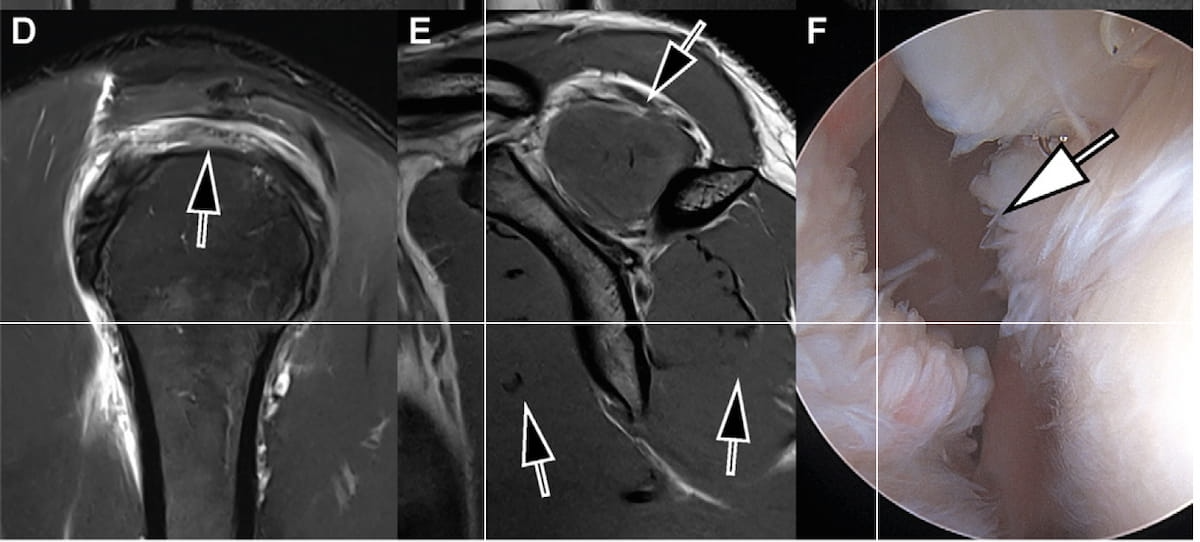The combination of threefold parallel imaging (PIx3) with deep learning for seven-minute 3T shoulder magnetic resonance imaging (MRI) scans appears to offer significant sensitivity for a variety of painful shoulder conditions.
In a new retrospective study, recently published in Radiology, researchers explored quality parameter assessments and use of the aforementioned seven-minute 3T MRI in 121 adults (mean age of 55) with painful shoulder conditions.
For supraspinatus-infraspinatus tendon tears, the seven-minute 3T MRI demonstrated 89 percent sensitivity, 90 percent specificity and an 89 percent area under the receiver operating characteristic curve (AUC), according to the study authors.
The researchers also noted 93 percent sensitivity, 99 percent specificity and a 94 percent AUC for Hill-Sachs deformities as well as 93 percent sensitivity, 73 percent specificity and an 83 percent AUC for superior labral tears.
“Our study results indicate that 7-minute PIx3-accelerated DL super -resolution shoulder MRI has high performance in the diagnosis of tendinous, labral, and osteocartilaginous shoulder abnormalities,” wrote lead study author Jan Vosshenrich, M.D., who is affiliated with the Department of Radiology at the New York University Grossman School of Medicine in New York, N.Y., and colleagues.
Using a five-point Likert rating scale, seven reviewing radiologists rated the quality parameters for the seven-minute shoulder MRI as four or higher with consensus ratings of 5 for fluid brightness and no reconstruction artifacts.
Three Key Takeaways
1. High diagnostic performance. The seven-minute 3T MRI using threefold parallel imaging (PIx3) and deep learning demonstrated high sensitivity and specificity for diagnosing supraspinatus-infraspinatus tendon tears (89 percent sensitivity, 90 percent specificity), Hill-Sachs deformities (93 percent sensitivity, 99 percent specificity), and superior labral tears (93 percent sensitivity, 73 percent specificity).
2. Improved workflow efficiency. The accelerated MRI protocol enables 15-minute appointments, significantly reducing wait times and improving patient access compared to conventional 30–45-minute MRI sessions.
3. Strong image quality ratings. Seven radiologists rated the image quality highly with a consensus rating of 5/5 for fluid brightness and absence of reconstruction artifacts, supporting the feasibility of this rapid imaging approach for clinical use.
The study authors maintained that the seven-minute shoulder MRI has significant potential in bolstering workflow efficiency and patient access to MRI.
“Conventional shoulder MRI with 20–30-minute acquisition times typically requires scheduling a 30–45-minute appointment, whereas the combination of 7-minute PIx3-accelerated DL super-resolution MRI, modern architecture (30), and an efficient MRI workflow (31) facilitates 15-minute shoulder MRI appointments, allowing a reduction in wait times and improved access to MRI,” emphasized Vosshenrich and colleagues.
(Editor’s note: For related content, see “Could an AI-Powered Enhancement of MRI be a Pre-Op Game Changer for Total Shoulder Arthroplasty?,” “Study Examines Impact of Deep Learning on Fast MRI Protocols for Knee Pain” and “Image IQ Quiz: Post-Trauma Shoulder Pain and Decreased Range of Motion.”)
Beyond the inherent limitations of a single-center retrospective study, the authors acknowledged potential bias due to a cohort entirely comprised of patients who had MRI and arthroscopic surgery, and orthopedic surgeon awareness of clinical assessments of MRIs. The researchers also conceded that differences between MRI and arthroscopy diagnoses may have been due to delays of up to 90 days between MRI and arthroscopy procedures.
